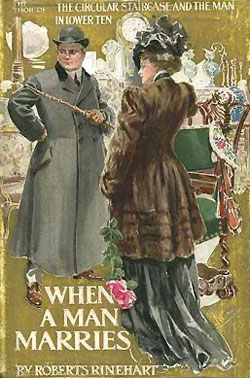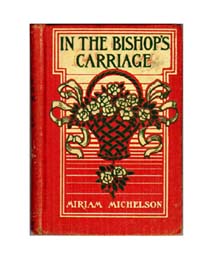 Since acquiring my Sony Reader, however temporary, I’ve found reading old books from Project Gutenberg has become a lot easier. I connect the USB cord to my laptop, download the book in ePUB or HTML form to the Reader, et voila! I have a novel or short story written by popular Edwardian writers at my fingertips. Many of the authors available on Project Gutenberg or other free ebook websites were extremely popular in their day and would be considered “pulp” novelists today–but just because their fiction hasn’t been canonized as “Classic Literature” doesn’t mean the books aren’t enjoyable. In fact, I find myself downloading more of their fiction than the works of authors published today because most are a perfect blend of humor, romance, and often, mystery, that remind me of romantic comedies and romantic mysteries filmed in the 1930s and 1940s. To dredge the annals of fiction for you, I shall present reviews of some of the books our Edwardian counterparts gobbled up and what I’ve greatly enjoyed today.
Since acquiring my Sony Reader, however temporary, I’ve found reading old books from Project Gutenberg has become a lot easier. I connect the USB cord to my laptop, download the book in ePUB or HTML form to the Reader, et voila! I have a novel or short story written by popular Edwardian writers at my fingertips. Many of the authors available on Project Gutenberg or other free ebook websites were extremely popular in their day and would be considered “pulp” novelists today–but just because their fiction hasn’t been canonized as “Classic Literature” doesn’t mean the books aren’t enjoyable. In fact, I find myself downloading more of their fiction than the works of authors published today because most are a perfect blend of humor, romance, and often, mystery, that remind me of romantic comedies and romantic mysteries filmed in the 1930s and 1940s. To dredge the annals of fiction for you, I shall present reviews of some of the books our Edwardian counterparts gobbled up and what I’ve greatly enjoyed today.
According to wikipedia, Mary Roberts Rinehart was considered the American Agatha Christie and popularized the phrase “The butler did it.” When A Man Marries is typical of both Rinehart’s “Had I but known” shtick (one I find many gothic romances employ) and the “society” fiction narrated in first person by a charming female that was popular after Elinor Glyn burst onto the literary scene with The Visits of Elizabeth (to be reviewed soon).
The plot is slight but oh-so ingenious, as the heroine, Kit, is roped into pretending to be her friend Jim’s wife, when his wealthy aunt, who is unaware that Jim has divorced the high-maintenance Bella, comes to supper. When Jim’s butler is stricken with smallpox, the house is quarantined, inadvertently trapping Kit into being “Bella,” a visiting policeman, the sneaky Bella, who came to the house to steal the butler she and Jim shared, and a handsome stranger with whom sparks fly . Toss into a jewel theft, and you have a wonderful, witty romantic mystery. Beware, there is a bit of offensive racial stereotyping in the beginning of the novel, with the Japanese butler as the butt of the joke, and the policeman’s Irishness and his lower-class status is used as fodder for his characterization, but as this was published in 1910, it is unavoidable. Otherwise, though the mystery element takes a backseat to the romance and the humor, it is sufficiently suspenseful to keep you wondering who the culprit is!
Excerpt:
The minute I had consented I regretted it. After all, what were Jimmy’s troubles to me? Why should I help him impose on an unsuspecting elderly woman? And it was only putting off discovery anyhow. Sooner or later, she would learn of the divorce, and—Just at that instant my eyes fell on Mr. Harbison—Tom Harbison, as Anne called him. He was looking on with an amused, half-puzzled smile, while people were rushing around hiding the roulette wheel and things of which Miss Caruthers might disapprove, and Betty Mercer was on her knees winding up a toy bear that Max had brought her. What would he think? It was evident that he thought badly of us already—that he was contemptuously amused, and then to have to ask him to lend himself to the deception!
When A Man Marries – Project Gutenberg
When A Man Marries – Many Books
Review – The Mystery File



I love stuff like this. Will look forward to more reviews.
This book sounds enjoyable. And I love that it’s free! Reading fiction in Project Gutenberg is a great idea–I wish I had an e-reader so it would be easier.
Thanks Victoria!
heidenkind–I love free books. *g* And though the e-reader is easier, I had no problem reading the HTML versions of books (though some books come only in .txt versions, ack!). I’d love to hear any other opinions of the book.
Oh this sounds like a wonderful story. Thanks for posting the information about it. I will have to read it or see if I can find it a local antique shop.
The posts on this blog are all very great quality. I could spend literally hours reading the posts on this website and never get bored. So anyway just wanted to say and let you know :).
While I appreciate the reviews–since I am doing research on Edwardian Era–it upsets me that your web site has also been attacked by the Politically Correct fear. I believe adults are the ones reading these books; so why the need to warn people of the “offensive racial stereotyping”? Is this a free country or what? So, although the book was written in the begining of the 20th Century, Americans still have the right to “feel offended”! (Sorry, but while I love this country I am really tired of Americans being so politically correct!)
I’m sorry you feel this way Emilia, but I reserve the right to keep my website inclusive, which acknowledges that I may have readers sensitive to particular issues. I also consider it a disservice to wholeheartedly recommend old literature as though the casual racism, sexism, etc should not get in the way of having fun. I don’t do it with the books I read which are published today, and I don’t think the culture in which these books were published make them exempt from scrutiny because so many authors did not let the common perceptions held about women or minorities determine what they wrote. If having caveats is “PC” then I will happily remain so. Thank you for taking the time to visit the site. I hope you find it helpful for your studies.